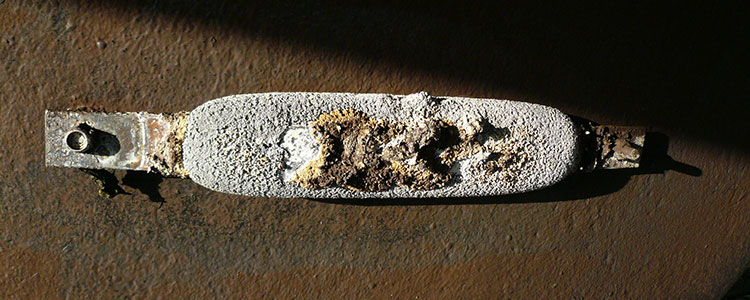
Anodes are in stock for immediate delivery for all of your ship, vessel, and marine requirements. Our anodes are available in zinc, aluminum, or magnesium (coated or uncoated). We specialize in Hull Anodes, Tank Anodes, Pier or Dock anodes, as well as boiler and condenser anodes.
We specialize in zinc and aluminum anodes for:
- Hull Anodes
- Tank Anodes
- Pier, Dock, Jetty or Wharf anodes
- Boiler anodes
- Condenser anodes
- Sacrificial anode
For more information please contact us at: Sales@FirstChoiceMarineSupply.com
Zinc Anodes
| Part Number | Lbs | Size | Description |
|---|---|---|---|
| EFL-Z-TD-6-W | 6 | 3″x9″x1-1/4″ | Weld or Bolt Galv Strap |
| EFL-Z-12 | 12 | 3″x12″x1-1/4″ | Weld on Galv Strap |
| EFL-Z-24T | 24 | 6-1/2″x14″x1-1/4″ | Weld on Galv Strap |
| EFL-Z-23C | 23 | 6″x12″x1-1/4″ | Weld on Galv Strap |
| EFL-Z-23CG | 23 | 6″x12″x1-1/4″ | Bolt on Galv Strap |
| EFL-Z-26 | 26 | 4-1/4″x14″x2-1/4″ | Weld on Galv Strap |
| EFL-Z-48 | 48 | 4-1/4″x14″x2-1/4″ | Weld on Galv Strap |
Aluminum Anodes
| Part Number | Lbs | Size | Description |
|---|---|---|---|
| EFL-A-6 | 2 | 3″x9″x1-3/8″ | Weld or Bolt Steel Strap |
| EFL-A-12 | 5 | 3″x12″x1-1/4″ | Weld on Steel Strap |
| EFL-A-24 | 10 | 6-1/2″x14″x1-1/4″ | Weld on Steel Strap |
| EFL-A-26 | 12 | 4″x14″x2-1/4″ | Weld on Steel Strap |
| EFL-A-48 | 20 | 4″x24″x2-1/4″ | Weld on Steel Strap |
| Part Number | Lbs | Size | Description |
|---|---|---|---|
| EFL-A-6 | 2 | 3″x9″x1-3/8″ | Weld or Bolt Steel Strap |
About Sacrificial Anodes
A sacrificial anode, or sacrificial rod, is a metallic anode used in cathodic protection where it is intended to be dissolved to protect other metallic components.
In basic terms it is a piece of more readily-corrodible metal attached by a conductive solid to a less readily-corrodible metal, with both metals immersed in a conductive liquid; typically fresh or salt water. The more active metal corrodes first and generally would need to oxidize almost completely before the less active metal will corrode. Because the anode reacts more readily it acts as a barrier against corrosion for the protected metal.

How Anodes Function
Described technically, a sacrificial anode can be defined as a metal that is more easily oxidized than the protected metal. Electrons are stripped from the anode and conducted to the protected metal, which becomes the cathode. The cathode is protected from corroding, i.e., oxidizing, because reduction rather than oxidation takes place on its surface.
For example when zinc and iron are put together (in contact) in the presence of oxygen and water, the zinc will lose electrons and go into solution as zinc cations. Electrons released from the zinc atoms flow by metallic conduction to the iron where, on the surface, dissolved oxygen is reduced, by gaining the electrons released by the zinc, to hydroxide anions. If the Zinc is not present, the same reduction of oxygen to hydroxide would occur on the iron surface; however, in that case, the electrons for reduction would be furnished by the iron thus oxidizing the iron. Therefore, the zinc, when present, is “sacrificed” by being oxidized instead of the iron. The iron is “safe” until all of the zinc has corroded.

